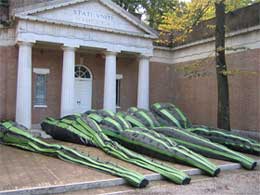 The US pavilion wasn’t my favourite. It is definitely not one of those pavilions invaded by architects who are too busy trying to be fine artists, curators, pseudo-comedians, or else they are making supper, texting, blogging or sweating in the sauna. I totally understand Jonathan Glancey’s point but his definition describes exactly the kind of architects i like!
The US pavilion wasn’t my favourite. It is definitely not one of those pavilions invaded by architects who are too busy trying to be fine artists, curators, pseudo-comedians, or else they are making supper, texting, blogging or sweating in the sauna. I totally understand Jonathan Glancey’s point but his definition describes exactly the kind of architects i like!
Still, the US pavilion was a great one. Its title is After the Flood. Five green inflatable tentacles greet the visitors in the courtyard of the pavilion. Conceived by Anderson Anderson Architecture, The Alluvial Sponge Comb is a prototype for flood protection. Made of superabsorbent material, the multifinger sponge captures water, swell and become a temporary flood barrier. Their design is meant to harmonize with the natural ebb and flow of water, rather than resist it. PDF with more details.
A first room inside the pavilion helps visitors understand the aftermath of Hurricane Katrina in New Orleans. The spectacular photographs of Michael Goodman were hanging on the walls of the second room. Each of them talked about the impact of the disaster on the land, the housing, the flora, and the detritus of human existence.
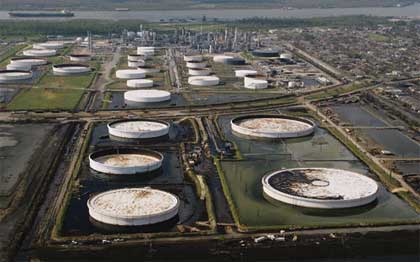 Flooding forced oil storage tanks off their foundations
Flooding forced oil storage tanks off their foundations
Neil Alexander’s images of the storm, its aftermath, and the city’s attempts at recovery are projected on the floor (they are excerpts from his upcoming documentary, An Eye in the Storm- New Orleans and Katrina Over a Year and a Day.)
The last rooms were occupied by models of the winners in the competition for multifamily housing. Eight Inc. (Honor Award) shows a horizontal slab tower which offers every one of the 160 units a river view.
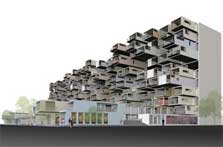
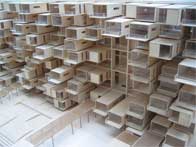 Eight Inc.’s proposal: rendering and model
Eight Inc.’s proposal: rendering and model
Anderson Anderson Architecture’s Camel Back Shot Gun Sponge Garden (love the way that name sounds) is a high-density urban housing landscape designed as an environmental sponge absorbing climatic impacts and slowly filtering the captured water and energy back into their natural and human eco-systems as useful nutrients. Rainwater is routed to planted decks on the roof and the insulated panel system also filters rain and supports planting, eventually becoming a “green wall.â€?
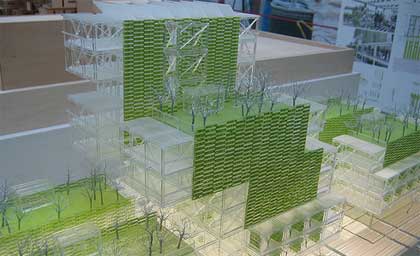 Camel Back Shot Gun Sponge Garden
Camel Back Shot Gun Sponge Garden
The crowd-pleaser of the exhibition is the proposal of Kiduck Kim and Christian Stayner (from Harvard University). Their idea is to “welcome the river inâ€? rather than treat it as “an unwanted guest.â€? When floodwaters threaten, residents would take refuge in truckable, two-level emergency modules pontooned to float up with rising waters. While solar-powered poles would delineate submerged streets and property lines, the modules would drift, tethered to utilities through unfurling umbilicals.
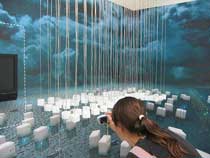
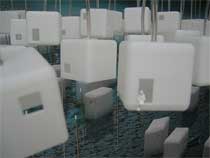 The emergency modules
The emergency modules
A nice pavilion thus. Serious, dealing with real-life and urgent issues, showcasing the work of young architects (as opposed to the usual suspects) and very didacting (i spare you the numerous graphics on the walls.)
My pictures are on flickr. Some of Goodman’s images are on ENR.
